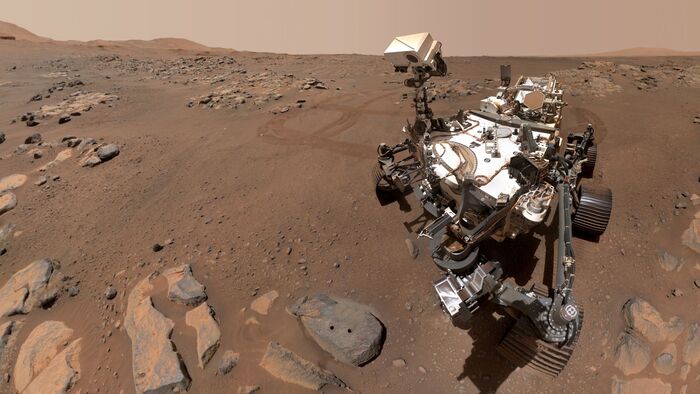Enlarge image
Microbiological work (here using the CRISPR / Cas process in a Berlin laboratory)
Photo: Gregor Fischer / dpa
Jill Banfield has worked in Japanese mines and geysers in the US state of Utah. But for what is possibly the most far-reaching discovery, she and her doctoral student Basem Al-Shayeb patted around on the muddy floor of a dried-out pool near their home. The Australian geomicrobiologist, who works at the University of California at Berkeley, has done fieldwork in her own neighborhood.
Together with Al-Shayeb, she was looking for traces of very special viruses. These pathogens attack primeval protozoa, so-called archaea, which often live under extreme environmental conditions. Banfield and her assistant were particularly interested in specimens that do almost entirely without oxygen - and in the viruses that infect them. In soil samples from the pond, the team first looked for all possible genome segments - and found billions of them. With the help of automated database research, it was then checked who was actually responsible for the genetic material found: bacteria, viruses - and more.
To their surprise, the researchers also found a previously unknown shape of extremely long, straight sections of genetic material. This contained, they report in a manuscript that has not yet been peer-reviewed, parts of the DNA of various types of bacteria. When Banfield told her son, a Star Trek fan, about it at Thanksgiving dinner last year, he immediately had the appropriate name ready: Borg.
In the sci-fi stories, this collective poses an immense threat to the United Federation of Planets, which includes us humans. In their pursuit of technological superiority, the Borg have a rather impractical quality for another species: They strive to incorporate it ruthlessly and, above all, completely. In the event of success, the independent existence of the species assimilated in this way unfortunately ends. Knowledge and experience exist only as part of the Borg community, which does without individuals.
Such aliens are not found in Banfield's soil samples, that much should be clear.
But that's where the certainties almost end.
Because what it is that the team has tracked down, there is a lack of clarity.
In principle, it could be evidence of previously unknown giant viruses, DNA from bacteria that have not yet been researched - or free pieces of genetic material that can also exist outside cells.
Researchers don't want to believe in coincidence
In principle, such free genetic information, researchers speak of extrachromosomal DNA, is well known, for example in the form of so-called plasmids. With their help, bacteria can exchange properties such as antibiotic resistance between different species. But these plasmids are usually circular and much shorter than the gigantic DNA ribbon, consisting of hundreds of thousands of base pairs, that Banfield and her team are now reporting.
The genetic makeup of the various Borg - around two dozen different gene sequences are now known, which have also been detected in other soil samples from the US west coast - therefore has characteristic patterns at the beginning and end and striking regularities in the course.
There are also indications that it could make copies of itself.
According to the researchers, one does not assume that the DNA is arranged in a random manner.
The Borg must have something to do with methane bacteria
W. Ford Doolittle, an emeritus evolutionary biologist at Dalhousie University in Halifax, Canada, who was not involved in the work, called the results "pretty exciting." He doesn't know of any extrachromosomal DNA that is as long "as these guys". And Brett Baker, a microbiologist at the University of Texas at Austin, speaks of structures "that have never been seen before." His colleague Huang Li points out that there have been repeated surprises in the field of extrachromosomal DNA in recent years. Undoubtedly, however, the current discovery has fascinated many researchers in his field.
It is interesting that the Borg appear to be associated with a specific group of bacteria that break down methane. As the main component of natural gas and biogas, methane is an important source of energy. But the compound is also a powerful greenhouse gas, which is around 30 times as effective as carbon dioxide over a 100-year period with the same weight. So far, researchers have not been able to cultivate the corresponding methanoperedent bacteria in the laboratory. Therefore, they cannot simply test the hypothesis that the Borg originated inside the bacteria.
The researchers suspect that it is possible that the Borg are remnants of non-existent bacterial species that have been absorbed into a different species - but are still clearly recognizable there, albeit modified again and again over time. If this interpretation were correct, it would actually be a bit like the "real" Borg in "Star Trek".
In any case, the newly found genetic material has genes that help process methane.
Banfield and her team speculate that the Borg could influence the corresponding efficiency of the methane-decomposing bacteria.
Specifically, they could possibly ensure that the microorganisms can break down the greenhouse gas better: “Borg are like turbo boosters for their host's methane metabolism.
That means they could have a significant impact on the climate, ”Banfield said on Twitter.
Theoretically, the new findings might make it possible to induce bacteria in the soil to break down more methane - and thus to stabilize the global climate.
But on the one hand that would be a long way off at best, and on the other hand it might involve massive risks.
First of all, Banfield now wants to study the Borg more thoroughly.
Since the discovery of regularly repeated sections of the genetic material in various bacteria and archaea - this is also the basis for the CRISPR / Cas gene scissors - she has not been so enthusiastic about a discovery, says the researcher: “We have found something puzzling that, like CRISPR, is linked to microbial genomes. "
Jennifer Doudna from the University of California, who, along with Emmanuelle Charpentier from the Max Planck Research Center for the Science of Pathogens in Berlin, was honored with the Nobel Prize in Chemistry for CRISPR / Cas last year, is co-author of the current manuscript.















